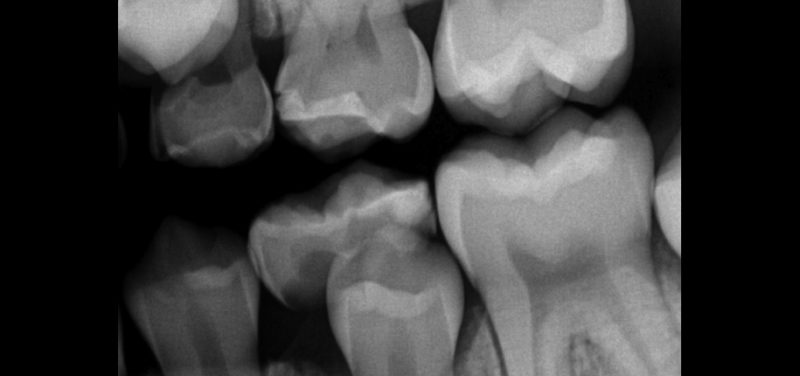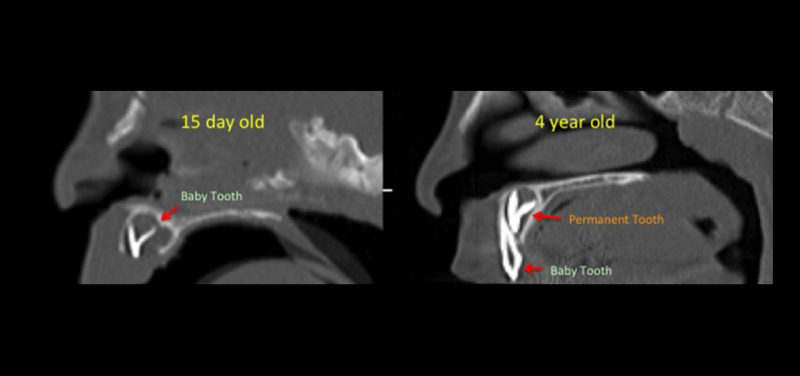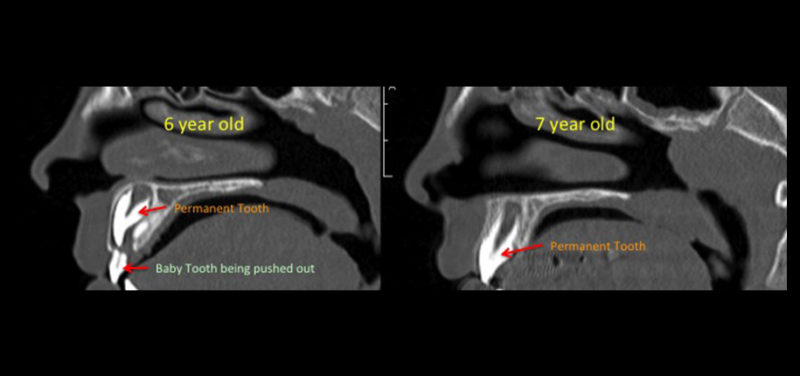
Odontogenesis, or the formation of teeth, is a complex multistep process requiring interaction between different cell types. This begins at approximately four weeks into utero life. Eventually, most babies will develop two sets of teeth. Twenty baby teeth grow in between 8 and 33 months of age, ultimately making way for 32 permanent ones. On x-rays, the bright white part of both baby and permanent teeth corresponds to enamel, or the outside hard portion of the tooth. On some special radiographs used by dentists, the dentin, or the inner softer portion of the tooth, is grey. For much of our childhood, both sets of teeth are visible on radiographs.
 Image: A typical tooth radiograph showing enamel (white), dentin (light gray) and pulp (dark gray)
Image: A typical tooth radiograph showing enamel (white), dentin (light gray) and pulp (dark gray)
On average, children lose their front teeth at about 7 years of age. Girls tend to lose their teeth a little bit earlier than boys. Infection can cause the loss of a tooth to occur earlier than its natural progression. Tooth loss can be temporarily painful, but should eventually subside with time and healing. Dental care should be sought if there is persistent gum pain, as this can be a sign that the underlying gum is infected.
 Image: Even though you can’t see them, a baby is born with a full set of 20 baby teeth that erupt, or break through the gum when the child is a few months of age.
Image: Even though you can’t see them, a baby is born with a full set of 20 baby teeth that erupt, or break through the gum when the child is a few months of age.
In many cultures, losing teeth is a rite of passage, and different cultures support a diverse array of stories about what exactly to do with the primary teeth. As you may know, in the US a child will probably be told to place the tooth under their pillow in return for a pick-up and reward by the Tooth Fairy. However, had that same child been born in certain areas of Europe, the tooth might have been picked up by a benevolent mouse rather than a fairy. In other countries, children throw their baby teeth onto a roof (South Korea) or into the sun (Iraq, Egypt and Jordan) for good luck and strong new teeth.
 Image: Larger permanent teeth form later, lining up behind the baby teeth and eventually pushing them out.
Image: Larger permanent teeth form later, lining up behind the baby teeth and eventually pushing them out.
A pressing question for parents is often how much to leave under the pillow. With the tooth inflation of some households leading to $5 and $20 per tooth windfalls, the average reward per tooth reimbursement in the US ranges from $3.07 in the South to $3.56 in the Northeast. Nevertheless, the most common amount left in a full 33% of households is a single dollar bill.
An important fact to remember is that no matter who comes to pick up your child’s tooth or what the associated exchange rate is, the loss of baby teeth is a perfect time to remind our children how important it is to care for their permanent ones. The American Association of Pediatric Dentistry recommends brushing twice for two minutes each day and flossing once, under adult supervision until the age of 8. Also, after the age of 1, children are recommended to see a dentist regularly. Don’t forget, the annual check-ups, cleanings, and x-rays are just as important as your daily dental care.
Contributed by Dr. Emilia Olson and edited by Tony Dandino, SPEC-MR QUALITY.
